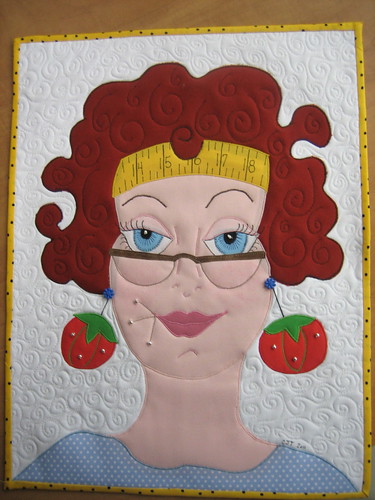We have declared 2012 as the year of "Back to Basics" at Patched Works.
Mastering quilting FUNdamentals will bring the "FUN" back into precision piecing!
We get seduced by intricate patterns, new trends or bad habits and sometimes forget the quilting fundamentals. Those fundamentals help us tackle quilt blocks with ease and finish projects more quickly.
The quilting trend in recent years focuses on big clunky squares and rectangles showcasing large pieces of fabric. The great thing about piecing big clunky shapes is quilts go together fairly quickly with very little muss or fuss. The bad thing about piecing big clunky shapes is that smaller pieces can seem overwhelming and frustrating.
Our goal is to make quilting more fun!
The first quilting FUNdamental is basic cutting.
We will teach basic cutting showcasing our exclusive line of acrylic rulers. Of course any good set of acrylic can be used to achieve quality results.
Cutting the Patched Works Way
Patched Works founder Trudie Hughes invented a series of 4 rulers that we continue to manufacture and distribute today as the gold standard of acrylic cutting tools.
The rulers have clean lines, a reduced number of markings to allow for clearer sight of the fabric, and great features that do not exist on other rulers.
Standard Ruler Features:
· Numbers are centered and read one direction. Easily spot the measurement required.
· Markings every ¼” and dotted lines at essential 1/8” markings.
· Intersection of 45° lines ¼” from the edge of the ruler ensures points won’t be lost in seams.
· Less frequent 90˚ line markings provide improved view of fabric.
Rotary Rule™ (The Original)
3 ½” x 24”
· A pioneer in the rotary cutting revolution.
· Thin design to minimize slide along fabric while cutting.
· 45˚, 60˚ and 90˚ lines
Rotary Mate™ (The Baby)
3 ½” x 12”
· Extends Rotary Rule™ into a 7" ruler.
· Perfect size for cutting small pieces.
· "Speedies" mark a quick cut used in many Trudie Hughes patterns for snowballs and other shapes.
· 45˚and 90˚ lines
Big Mama™ (The Favorite)
6 ½” x 12”
· Extends the Rotary Rule™ or Rotary Mate™ into a 10” ruler.
· Use for most sub-cuts.
· 45˚and 90˚ lines
· Combine rulers using numbers along the long edge.
Big Daddy™ (The Strip Cutter)
6 ½” x 24”
· Perfect for large pieces.
· Heavy weight makes clean up cuts a breeze.
· 45˚, 60˚ and 90˚ lines
Advanced Techniques:
· Rulers may be used in pairs for straightening and squaring.
· Rulers may be paired in a parallel or perpendicular position.
· Use multiple rulers to leapfrog across the fabric.
· Consider ruler pairs instead of large acrylic squares to reduce the risk of acrylic slip.
Patched Works recommends the use of Invisigrip™ to reduce the slide of all brands of rulers.
Locally designed and manufactured in Wisconsin.
Straightening Cut
Fold fabric in half selvage sides together away from your body, folded edge towards your body.
Line up a straight edge of the Big Mama™ along the folded edge of your fabric with the raw edge exposed to the left.
Position a long strip cutter like the Rotary Rule™ or Big Daddy™ flush to the edge of the Big Mama™.
Move aside the Big Mama™, firmly hold Rotary Rule™ or Big Daddy™ and make a rotary cut using one continuous cutting motion.
**If the long ruler shifts, start over.**
Cutting Basics
**Hold the ruler firmly in the center. Fingers should be away from the edge.
**Stand directly in front of ruler.
**Rotary cutter should be perpendicular to the mat. Cutting with the blade at an angle will skew cut.
**Start off the edge of the fabric and firmly cut in a continuous motion.
Strip Cutting
Accurate cutting is your first step to accurate piecing!
After fabric is straightened, DO NO PICK FABRIC UP! Carefully fold the selvage edge in.
This allows a shorter cut.
You may need to restraighten your fabric every 4 cuts or whenever you move your fabric.
Cut accurate strips by aligning a 90˚ line of the ruler along the bottom fold and the measurement line along the left edge.
Note: Hand on ruler is not in place to illustrate the positioning of the ruler for a strip cut.
Restraighten fabric when fabric edge is no longer a 90˚ angle.
Practice makes perfect! We offer a "Let's Get Started" drop in class twice a month to help you beginners get started.
Have fun and happy quilting!






























